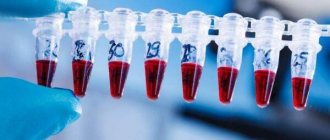Tuberculosis is a dangerous and difficult to treat disease. The effectiveness of treatment depends on how timely it was detected. No one is immune from infection; absolutely everyone can get sick - adults, children, the elderly.
In the absence of the necessary timely treatment the closed form turns into a dangerous open form , so diagnosis in the early stages of the disease is extremely important, and this can be achieved through regular and comprehensive examinations.
In this article we will look at various methods for diagnosing this pulmonary disease, and also try to determine which blood test for pulmonary tuberculosis is most reliable and informative.
Odnoklassniki
Low red blood cell levels
Few people like to take a blood test. However, you can’t do without it. A general blood test will show in time that the level of hemoglobin and red blood cells is significantly reduced. These changes do not constitute a basis for diagnosis. But this is a reason for more detailed research.
A decrease in these indicators indicates the presence of an inflammatory process.
If the time has not yet come for fluorography, whether there are symptoms of a pulmonary infection or not, but you want to make sure that Koch’s bacillus has not entered the body, it is rational to take a routine test.
Inflammation in the body of any etiology is always a cause for concern. Perhaps we will find out that he is not there?
When is the presence of bacteria diagnosed?
There are several types of Koch bacillus. These microorganisms can live in soil, water and in the human body, but remain passive and do not reproduce. Under unfavorable circumstances, the population grows and the disease begins. They can enter the body not only through airborne droplets, but also through food, for example.
Depending on the type of Koch bacillus, tuberculosis of different types develops. It happens that only blood tests are informative for tuberculosis, and not mantoux, for example. This is exactly what happens with the miliary variant. Mantoux will not necessarily cause a reaction.
An exacerbation, the appearance of symptoms such as fatigue, loss of appetite, increased sweating at night, and a dry cough will make you worry. But it will be difficult for the person himself to associate these symptoms with tuberculosis. But the doctor can rely on the results of the mantoux and make a mistake.
A blood test will reveal the problem. Only blood tests will alert you to tuberculosis of the genitourinary system. Urine may not change significantly in composition, and the only symptom that will bother you is a mild aching pain in the lumbar region.
How long can microorganisms remain latent in the human body?
Doctors call people who do not have tuberculosis, but are carriers of this parasite, tuberculosis infected. Koch's wand sometimes lives in the body for several days, and sometimes for 7-10 years.
Clinical symptoms of tuberculosis
Most often, the disease is detected during a routine examination of the sick person.
With pulmonary tuberculosis, the patient may suffer from low-grade fever, cough, general weakness and weight loss. In the later stages of the disease, chest pain appears, a dry cough is replaced by a wet one, and pulmonary bleeding is possible. The following groups of people are at risk for tuberculosis:
- patients with immunodeficiencies and chronic systemic diseases;
- people constantly taking medications based on glucocorticosteroids;
- smokers and people who abuse alcohol;
- patients who underwent a course of immunosuppression before organ transplantation;
- people living in unfavorable living conditions.
Also, the likelihood of becoming infected increases with prolonged contact with sick people. Studying the patient's medical history helps to identify the disease in a timely manner.
Open form - studying the immune response
The development of the disease can be caused by infection with a large number of microorganisms, depletion of the immune system due to stress, colds, hypothermia, HIV infection, etc. Treatment is complex, difficult to tolerate, and there is a high mortality rate among those suffering from the pulmonary form.
A positive result is the transition of tuberculosis to a closed form from an open one, without complications. A blood test for pulmonary tuberculosis helps to adjust treatment.
In the open form, there is a severe cough, bleeding during expectoration, and high fever.
Koch's wand destroys the alveoli and poisons the entire body with toxins. Blood in acute tuberculosis is examined in order to determine the degree of intoxication and take timely measures. This analysis shows the condition of other organs and systems. Aggressive therapy is needed, but it can affect the functioning of the liver and kidneys. In order to notice complications in time if they suddenly appear, they donate blood in case of acute tuberculosis.
The appearance of pronounced, clear symptoms in a patient is preceded by an incubation period. The disease is most easily treated if it is detected at this stage.
Biochemical
When performing this test, blood is drawn from a vein, and the result is obtained the next day. If the indicators are correctly deciphered, serious diseases can be identified at an early stage. Unfortunately, a biochemical blood test for tuberculosis does not provide an accurate diagnosis. The research has the following objectives:
- periodic monitoring of the treatment process;
- correction of homeostasis disorders (ensuring stability of the internal environment of the body);
- identifying the effects of medications and side effects.
In tuberculosis, biochemical blood parameters depend on the stage of the disease, complications, and concomitant pathologies. When deciphering the analyses, note:
- with an inactive type of infection, total protein and protein fractions of blood serum are normal;
- in the acute course of the disease, when the chronic form of tuberculosis infection begins to progress, the albumin-globulin coefficient decreases (the norm is 15.-2.3).
Biochemical research during the development of a bacterial infection helps to dynamically monitor the condition of the liver and kidneys. To assess the patient’s well-being, especially in severe cases of the disease, pay attention to the following blood indicators for tuberculosis:
- direct and total bilirubin (below normal);
- AST – aspartate aminotransferase (increases);
- ALT – alanine aminotransferase (increases).
Diagnostics in closed form
A person with a closed form of tuberculosis is not dangerous to others and hospitalization is not necessary. Blood tests for this type of tuberculosis are carried out as part of preventive examinations. When the form is closed, pathological changes of varying degrees are visible on the fluorographic image - scars on the inner surface, the so-called pulmonary fibrosis. They may not cause concern in the future.
The formation of scar tissue in place of damaged normal tissue is a natural protective reaction of the body. Under unfavorable conditions, they can cause the progress of destructive processes. This defensive reaction, although natural, is not effective in some cases.
These changes are irreversible and lead to a decrease in the efficiency of the respiratory system. Blood tests for closed tuberculosis help to detect deterioration in health in a timely manner.
Sometimes an operation is performed to remove the part of the lung most severely affected by Koch's bacillus.
It is necessary to control the rehabilitation process. Even if the doctor does not insist, it is advisable to donate blood for closed, chronic tuberculosis from time to time, and show initiative. Relapses are possible. You need to make every effort to not get sick again.
Some tests are expensive. But there are also inexpensive ones. It is better to donate blood once every six months for this form of tuberculosis to check the immune system and body function than to constantly fear the manifestation of complications.
According to statistics, people who have had this disease are more likely to face a problem such as lung cancer.
Do they donate blood for osteoarticular tuberculosis?
There is no information about the relationship between bone cancer and osteoarticular tuberculosis. But tests still need to be taken for prevention. It is easier to avoid many diseases if you undergo the most relevant preventive examinations on your own initiative every six months.
Diagnosis in childhood
The presence of Koch's bacillus in the body can be diagnosed in both adults and children.
If a blood test or fluorography revealed a problem?
All measures must be taken to improve the situation.
If the information is provided by the manta, the child is prescribed a blood test, urine test, sputum test, test for helminthiasis, and x-ray. The same tests are needed if fluorography results are negative. Depending on the results, they are assigned the status of tuberculosis infected or not.
In children, mantu can only provoke an allergic reaction. The child may scratch the injection site. In this case, too, the truth will soon be established and the hypothesis about the presence of infection will be refuted. To prevent the development of the disease, isoniazid is usually prescribed. This drug can be used to prevent tuberculosis in both children and adults.
Prevention of tuberculosis
To prevent the disease, children are vaccinated with the BCG vaccine in the first days of life. Already 2 weeks after the vaccine is administered, children begin to develop anti-tuberculosis immunity, which lasts for 5-7 years. At the ages of 7 and 13 years, revaccination is carried out. Vaccination significantly reduces the likelihood of disease: among vaccinated people, the incidence of tuberculosis infection and mortality are lower than among unvaccinated people.
To diagnose tuberculosis, children under 15 years of age undergo an annual Mantoux test, which is also called a tuberculin test. Patients are injected subcutaneously with tuberculin, a mycobacterial antigen. The study shows the presence of sensitization of the body to Mycobacterium tuberculosis or the vaccine. The tuberculin test does not provide immunity to the disease.
The Mantoux test is not highly specific. The result may be positive in people who have recently had tuberculosis or are allergic to tuberculin. Diaskintest is used to detect tuberculosis, differential diagnosis of infectious allergies and hypersensitivity to the BCG vaccine.
The drug contains artificially synthesized antigens of the cell wall of mycobacteria. A reaction to Diaskintest occurs during an active pathological process, except in cases where the patient suffers from concomitant immunopathological disorders. A negative test is also observed in patients in the early stages of infection.
In order to prevent pulmonary tuberculosis and other diseases of the chest organs, adults and adolescents over 15 years of age should undergo fluorography once every 2 years. People working in medical institutions, schools, kindergartens, and the catering industry are examined at least once a year.
More detailed research
What blood tests are needed for tuberculosis?
A general blood test will suggest that there may be a problem. He will warn, give a clue, make you wary. It may not be taken if the goal is prevention.
Perhaps it is worth choosing more informative tests instead of OAC?
Diagnosing this disease only by deviation from the norm in the concentration of red blood cells in children and adults is a major task.
If tuberculosis is in the body, blood tests should provide information about ESR. This is the sedimentation rate of red blood cells. If the ESR is elevated, it means that not only inflammation is present in the body, but also the process of removing toxins is disrupted.
In the case of tuberculosis, ESR increases due to tissue inflammation and due to the accumulation of toxins produced by these microorganisms. ESR can also be used to determine pathological changes in tissues such as necrosis and more.
These blood parameters are often not studied in the general analysis. A general blood test determines professional suitability, for example, functional deviations. In many laboratories you can undergo more detailed diagnostics for a fee, on your own initiative, without a doctor’s referral. Before symptoms appear, it will become clear that the situation is dangerous and help and medication are needed.
If you can’t decipher the analysis, you should consult a therapist. However, they are easy to decipher. Decrypting it yourself will not take much time. It happens that only one indicator arouses suspicion.
What to do in such a situation?
The disease is determined by a combination of symptoms.
Forecast
Tuberculosis is a fatal disease, so it is not recommended to ignore its presence, so as not to worsen the prognosis for further development and not to shorten your life expectancy.
The sooner treatment is prescribed, the better. Doctors have effective treatments that help in the early stages of the disease. However, if you neglect your disease state, then disastrous consequences are possible, in which we are already talking about how long patients with tuberculosis live.
Specific tests
Even if deviations from the norm are found in the general, most significant indicators, you will need to submit sputum or saliva to the laboratory and undergo fluorography. In first place in importance among people at risk is an enzyme-linked immunosorbent test, which determines the presence of specific antibodies.
Polymerase chain reaction testing is the most effective and accurate diagnostic method. It allows you to detect Koch's bacillus DNA in biological material. Unfortunately, this requires special equipment. Not every laboratory has it.
What tests are best to take for prevention?
To determine the problem and interpret poor health, it is sometimes important to know what a general analysis will show. In another situation, it is important to know what specific studies have shown.
Carrying out the Mantoux reaction
The body's reaction during Mantoux is one of the first diagnostic procedures. The doctor necessarily prescribes it not only when there are suspicions of tuberculosis, but also when the patient has previously suffered from this disease. It is also carried out during periods of epidemic outbreaks, especially for people at risk. If the patient is in contact with a person with tuberculosis, then he is also given a Mantoux test.
An injection is made in the forearm area through which tuberculin is injected - this is a substance of protein mass and mycobacteria. A red spot appears at the injection site, which may then itch. This area should not be wet or rubbed as this may distort the test results. If the Mantoux test shows unsatisfactory results, then other tests are prescribed.
If severe itching occurs at the puncture site, accompanied by aching, then you should apply a damp towel to the injection for no more than 10 minutes. There is no need to hold it longer to prevent water from penetrating under the skin. Sometimes the piercing can swell a lot. In this case, you need to consult a doctor.
If Mantoux does not show reliable results, then the following tests are performed:
- Enzyme immunoassay, which provides a 60% guarantee of results.
- Polymerase chain reaction, which shows the presence of bacterial DNA in the body.











